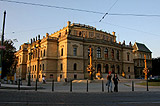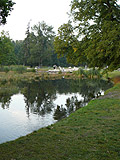The Invasion of 1968 in Pictures
Aug 27, 15:50 Filed under history
 On the 21st of August 1968, Czechoslovakia was invaded by the troops of Warsaw-Pact. It was a shock for the whole world. No one could believe that Czechoslovakia, which was an ally of the USSR, was actually attacked by the Soviets. Doesn’t it sound strange even nowadays?
On the 21st of August 1968, Czechoslovakia was invaded by the troops of Warsaw-Pact. It was a shock for the whole world. No one could believe that Czechoslovakia, which was an ally of the USSR, was actually attacked by the Soviets. Doesn’t it sound strange even nowadays?
Czechoslovak “friends” and “allies” – GDR, Poland, Hungary, Bulgaria and the USSR – broke into the sovereign country. They were neither invited nor welcome. Would you welcome a friend with a loaded gun ready to shoot?
Those “brothers” came to put an end to the Prague Spring which was a very short period of political and economical liberalization in Czechoslovakia in 1968. Czechoslovak leaders, though communists, saw the immense need for reforms. They tried to create “Socialism with Human Face”. However, it is to say that they never wanted to change the system into a real democracy.
 Nevertheless, despite the fact that Czechoslovak leaders were communists with every cell in their bodies, the Soviets were very nervous. They could see that the people in Czechoslovakia wanted more than few reforms, and so they had to act quickly in order not to let Czechoslovakia go out of their sphere of influence. And so they sent hundreds of thousands of troops and thousands of tanks to one of their allied country and called it a “brotherly help”.
Nevertheless, despite the fact that Czechoslovak leaders were communists with every cell in their bodies, the Soviets were very nervous. They could see that the people in Czechoslovakia wanted more than few reforms, and so they had to act quickly in order not to let Czechoslovakia go out of their sphere of influence. And so they sent hundreds of thousands of troops and thousands of tanks to one of their allied country and called it a “brotherly help”.
Czechoslovak people were shocked and confused at first. “Russians are invading us? What??? That must be a terrible misunderstanding”, they thought. And so they tried to explain to the Russians that there is no contra-revolution in Czechoslovakia. But it didn’t help. People were in agony. Many people, however, were ready to fight for the right of a sovereign state.
During this “brotherly help”, many Czechs and Slovaks got killed and hundreds were seriously wounded. It was a horrific scene – people with bare hands standing against Russian tanks with ball-cartridge. Friends turned out to be the worst enemies. Illusions were gone. The hopes for at least slight democratization were lost. People were crying. It was a truly sad and emotional moment.
However, it is impossible to describe it all. Pictures can tell much more than words. You will understand the situation much better after visiting the exhibition of authentic black-and-white pictures by Josef Koudelka at Prague’s Old Town Hall. It is right next to the Astronomical Clock at the Old Town Square. The exhibition takes place till September 10th. The closest metro station is Staromestska (green line A).
 Have you ever been to the
Have you ever been to the  Matej Kren is quite well-known artist. He was born in Trencin, then Czechoslovakia, today Slovakia. He studied at Art Academies in
Matej Kren is quite well-known artist. He was born in Trencin, then Czechoslovakia, today Slovakia. He studied at Art Academies in  Have you already visited the Austrian capital? It is a place which is definitelly worth of visit. And it should be noticed that there used to be extremly strong connections betveen Vienna and Czech country. As Bohemia and Morivia vere both parts of Austro-hungarian empire with its capital in Vienna. There were the seat of emperor, who was thus also Czech ruler. Only exception was Rudolf the second, who moved the throne to mystical Prague, and thus made it the centre of empire, but only for a short time. After his death, the next emperor moved the administrative cenre of the monarchy again to Vienna. And as the seat of the ruler, it was also the centre of the official culture and education in the monarchy.
Have you already visited the Austrian capital? It is a place which is definitelly worth of visit. And it should be noticed that there used to be extremly strong connections betveen Vienna and Czech country. As Bohemia and Morivia vere both parts of Austro-hungarian empire with its capital in Vienna. There were the seat of emperor, who was thus also Czech ruler. Only exception was Rudolf the second, who moved the throne to mystical Prague, and thus made it the centre of empire, but only for a short time. After his death, the next emperor moved the administrative cenre of the monarchy again to Vienna. And as the seat of the ruler, it was also the centre of the official culture and education in the monarchy.  Sigmund Freud wrote his extremely infuencial books… and there were many others, Vienna was the extremely important centre of the European culture that time.
Sigmund Freud wrote his extremely infuencial books… and there were many others, Vienna was the extremely important centre of the European culture that time. to Vienna through Brno, it is possible to go by bus and it is not that close, so it is better to stay there overnight.
to Vienna through Brno, it is possible to go by bus and it is not that close, so it is better to stay there overnight.  The institution of the Czech National Library needs a new building. Now the library is placed in the old
The institution of the Czech National Library needs a new building. Now the library is placed in the old 
 Bratislava is the capital of Slovakia. As you know, until 1993 there were no Czech or Slovak Republics, but
Bratislava is the capital of Slovakia. As you know, until 1993 there were no Czech or Slovak Republics, but  There are some old monuments, so it is good to take a walk in old town, to see gothic Saint Martin’s church, Michael’s Gate, Main Square and just stroll a bit in beautiful streets. Maybe you can also hike a bit to see the castle. The old town is small compared to Prague, but there are other touristic attractions beside it. Bratislava has interesting modern architecture. Highlight is definitelly one of the bridges across Danube river, which is called UFO, because of characteristic form on one of its ends, which looks like a space ship. It is possible to take a lift into “space ship“, and enjoy the amazing veiw all over the city from it. There is also a restaurant located inside, it must be great to enjoying the view while eating, but the prices here are pretty high.
There are some old monuments, so it is good to take a walk in old town, to see gothic Saint Martin’s church, Michael’s Gate, Main Square and just stroll a bit in beautiful streets. Maybe you can also hike a bit to see the castle. The old town is small compared to Prague, but there are other touristic attractions beside it. Bratislava has interesting modern architecture. Highlight is definitelly one of the bridges across Danube river, which is called UFO, because of characteristic form on one of its ends, which looks like a space ship. It is possible to take a lift into “space ship“, and enjoy the amazing veiw all over the city from it. There is also a restaurant located inside, it must be great to enjoying the view while eating, but the prices here are pretty high.  Another place I like in Bratislava is a chocolaterie on Michalska Street, where they offer many delicious hot chocolates. So many that it is really hard to choose one. And some of them are really attractive, either with fruits, liquors, rum or spices. Beside this, they also have desserts…
Another place I like in Bratislava is a chocolaterie on Michalska Street, where they offer many delicious hot chocolates. So many that it is really hard to choose one. And some of them are really attractive, either with fruits, liquors, rum or spices. Beside this, they also have desserts… 